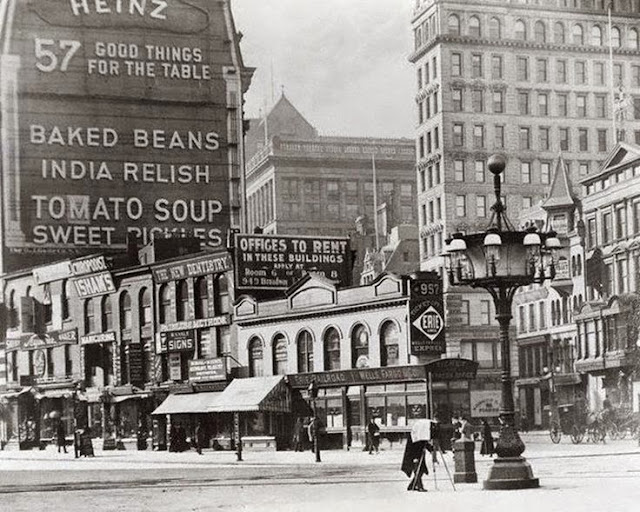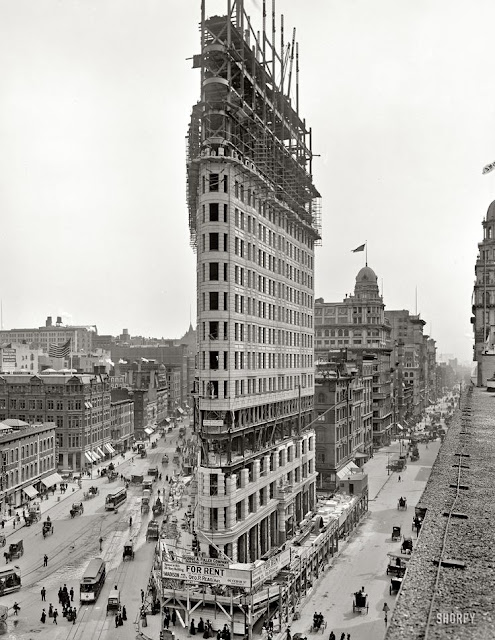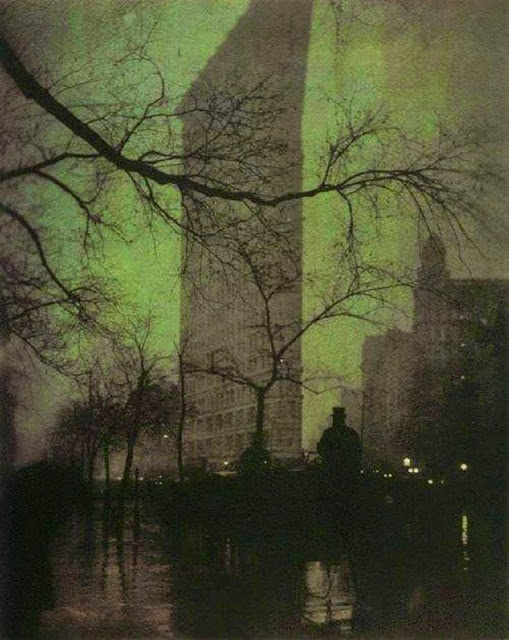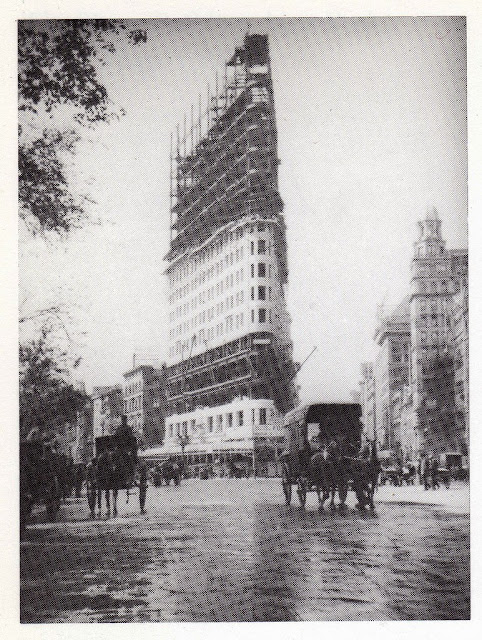Flatiron Building
 |
| The Flatiron Building in Manhattan. |
An Iconic Symbol of New York City
The Flatiron Building, originally (and only officially) called the Fuller Building after a real estate company that owned it, is located at 175 Fifth Avenue in the borough of Manhattan, New York City. It was built in 1902 by Daniel H. Burnham, an architect of the Chicago school.
First, A Little History About the Flatiron Building
 |
| Future site of the Flatiron · "Madison Square" 1828. View north from 21st Street looking up Broadway to Bloomingdale Road. The road turning to the right is the Boston Post Road in front of the wall of the former Arsenal, currently the House of Refuge for Juvenile Delinquents in this view. This was practically the frontier at the time, and it is astonishing that some people who saw this view may have seen some of the ones below, too. |
There are certain intersections in New York City, of which Times Square is the most famous, where Broadway crosses across at an angle. This is because Broadway predated the 1811 grid pattern imposed by urban planners on Manhattan Island north of the then-developed areas in the south. The urban planners decided to keep the existing streets and build the new grid pattern around them because Broadway was known at the time as the Bloomingdale Road.
It was considered smart to keep the Bloomingdale Road because it was well-established, was the main road to New England, and the areas of Manhattan that now are known as Midtown and the Upper West Side weren't going to be developed anytime soon anyway (they were basically undeveloped farmland at that time aside from outposts on Broadway and a few other scattered locations). That led to diagonal lots such as the one now occupied by the Flatiron Building. Land always being so precious in Manhattan, owners put it to use even though that meant erecting buildings that had diagonal shapes. The Flatiron Building is the most famous of those buildings, but there are several others. Some other oddly shaped buildings resulting from this situation are at Times Square, Columbus Circle, and Verdi Square (West 73rd Street), but there are others as well.
 |
| The site of the future Flatiron Building, here in 1884. It appears to be the winter. At that time, this was a major intersection in the city, along the lines of Times Square now. That is the Cumberland Hotel with the 'porous plaster' sign. Apparently, Benson's Capcine Plaster is better than Allcock's because it has 'certain medical ingredients' - who knew? It's also interesting to see not a single motorcar in these familiar streets - they still were a good 15 years away. There must have been quite an odor in those streets. |
The original site of the Flatiron Building had a building of a similar configuration, but the Fuller Building was on a completely different scale. Among the tenants on the site were the Erie Railroad offices (which had been there for decades), Wells Fargo, a dentist who used 'painless methods,' a chiropodist, a manicurist, and, behind it, a dealer in oriental rugs.
 |
| A dramatic illustration of 23rd Street and Fifth Avenue, where the Flatiron Building would soon stand. From here you can see the taller Cumberland building which would be used for billboards. |
The top of the low-slung building there was prime advertising space, much like the north side of Times Square later would become.
 |
| This is the future site of the Flatiron. On the right in the background is the Sohmer Piano Building, a Neo-classical Beaux-Arts building located at 170 Fifth Avenue at East 22nd Street, in the Flatiron District neighborhood of the New York City borough of Manhattan, diagonally southwest of the Flatiron Building. Designed by Robert Maynicke as a store-and-loft building for real-estate developer Henry Corn, it was built in 1897-98. It is easily recognizable by its gold dome, which sits on top of a 2-story octagonal cupola. Note the 'offices to rent' sign there, considering the whole block shortly would be gone. This picture was taken sometime between 1898 and 1900. |
The dates of early pictures taken of the Flatiron Building are sometimes hard to pin down.
 |
| I like this shot because of the photographer shown in the lower right corner. The Heinz kept changing, too. |
However, the site, which had a low-slung professional building on the location, was cleared for construction around 1901. The building itself was completed in 1903.
 |
| In 1901, the crossroads of 23rd Street, Fifth Avenue, and Broadway had not yet taken final form. The Flatiron Building was just beginning construction--which you can see from the big white fence wrapped around the site. The grand Heinz 57 ad on the side of the Cumberland Hotel was the first electric sign in the U.S., illuminated by 1,200 bulbs that used $90 of electricity a year. It was such an important intersection then that the cost was well worth it. There appear to be a couple of painters working on the Cumberland, but they needn't have bothered: within a year, both the sign and the Cumberland would be demolished. |
The Flatiron was the subject of a lot of classic shots shortly while it was being built. You always had the standard distant, tree-lined shot with the hansom cabs, the ladies walking by, and a peekaboo shot of the Flatiron itself in the distance.
 |
| I love this picture from 1900 because of what it does not show. Specifically, it does not show the Flatiron Building, which was still a few years away from completion. Instead, what it shows is the archetypal "Flatiron shot" of the tree-shaded sidewalk, women walking by in what we now would call 'period costume' (their normal dress) - and yet, no Flatiron. I love the crispness of this shot, it looks like it could have been taken for a film only last year. If you look through the trees, you can see the billboards on the low office buildings on the corner that are more obvious on the shots above. When anyone ever tells you that the past was nothing but horrors and this and that bad thing - think of this shot. |
The 23rd Street area was the center of city life at the turn of the century. It was like 42nd Street is now. It was an area for women to promenade and men to offer them a ride.
 |
| It is easy to assume that the Flatiron Building attracted photographers to a previously uninspiring site, but the reality is that the shutterbugs were there well before it was built. Here is a Spring Shower photo by Alfred Stieglitz. Circa 1900, showing the same type of ambiance he would create after the building arrived a few years later. |
There was a gentility that was enhanced by the elaborate fashions of the day.
The Great Building Arrives
 |
Under construction 1901
|
Many professional photographers were located nearby (note, for instance, the signs in some of the shots).
 |
| 1902. The horse still rules the road. |
This was unusual because there weren't that many photographers at all in those days. Remember, though, that "Hollywood" was just a few blocks down on 14th Street then and would be until 1911.
 |
| Flatiron 1902, just completed. |
 |
| Flatiron, June 1902. New York City was still a horse and buggy town at that time and they were trying to rent out the immense office space in the gleaming new tower. There also is a nice view of a classic street clock, some of which are still around (but not that one). |
The technology was still fairly new, and the new building was a perfect showcase for their abilities.
 |
| Colonel Donovan and staff of 165th Infantry, passing under the Victory Arch on 23rd Street and Broadway across from the Flatiron Building. The Arch was removed soon after. 1919. (by The U.S. National Archives, via Flickr) |
Around the time of World War I, the intersection of Broadway and Fifth Avenue was one of the city's great centers. The victory parade for World War I focused on the square, which is so massive that they were able to erect temporary columns and a wooden victory arch as in Roman days which the marchers could pass through.
 |
| Flatiron Building in a very interesting composition. Old Pics New York City! - Page 135 - SkyscraperCity. I don't have a date on this surprisingly crisp early shot, but the scaffolding and horse-drawn wagons suggest it was during the building's construction, ca. 1903. |
 |
| Flatiron, 1920s? That appears to be a recruiting center with guns sticking out. |
Thus, we are fortunate to have a number of early photographs from the earliest days of the Flatiron.
It sits on 23rd Street at the base of Madison Square Park, which used to be a much bigger deal than it is today. The park and surrounding area have revived recently and the Flatiron District has been "hot" in real estate circles.
 |
| Stieglitz, 1903. |
Compare the Stieglitz photo from 1903 from the recent one below.
 |
| Flatiron on February 3, 2014. |
The Flatiron (as everyone calls it) is considered to be a groundbreaking skyscraper. Upon completion in 1902, it was one of the tallest buildings in the city and one of only two skyscrapers north of 14th Street.
 |
| Flatiron, 1903. Brand new. This is a standard location for shots of it, as we will see. All horses and buggies. |
 |
| 1905, looking south from Madison Square Park, looking down 5th Avenue in the center. Not much different than the picture from 2014, or the one above from 1903, eh? Cars became ubiquitous by 1905, but here there may be only one over there on the left amidst the carriages. |
 |
| Flatiron, 1905, winter. Nice shot of the streetcar, with the stop just kind of 'there' in the middle of the intersection. Imagine that now! |
My apartment is about 8 blocks south of the Flatiron Building, located in the neighborhood named for that iconic structure.
The Flatiron is one of those buildings that will catch your eye even if you've walked past it a hundred times - which I have.
 |
| Flatiron around 1918, wintertime. Still looks uncannily like this. |
My most interesting walk by it, though, involved the little-known (by outsiders) statue of General Worth just north of the Flatiron, in the intersection with Broadway. This happened during the ricin scares of the early 2000s. A cop had his back to me and was scooping up some white powder at the base of the statue. No barriers there, just the cop and the powder dumped beneath the statue of the General.
 |
| Flatiron 1904. |
He suddenly turned and shouted at me excitedly to get away, because it might be ricin, and when I didn't run screaming out into the middle of traffic seemed a little perturbed. All I can say is, in New York City, you take stuff like that in stride. I'm still here, so I guess it wasn't ricin. Could have been.
 |
| 1905, a slightly different angle. This picture is a bit more romantic, I think. |
I've always been curious what it is like in the offices situated closest to these shots, the ones with the narrowest width.
 |
| This is a colorized version of a shot taken right around the time the Flatiron building was built. |
 |
| You can't make this photo with the shadow today. From Rudy Burkhardt, circa 1940 |
 |
| Flatiron Building circa 1950. Nice double-decker Fifth Avenue bus. |
New Yorkers, especially from the neighborhood (of which I am one), tend to think of the Flatiron Building as that big hunk of rock to get around at 23rd Street, where there is an express stop on the subway and a key transfer point.
 |
| Gotham at night. This looks like it came out of a Batman movie. Look toward 2 o'clock and you see the Washington Square Arch. I feel as though I should have a martini in hand and Sinatra on the player with romantic shots of this sort. |
However, it is more than that, it also is a symbol of the entire midtown south area, though because of the preeminence of the Flatiron Building as an iconic landmark, an entirely new designation for its locale - the Flatiron District - has come into use.
We don't spend a lot of time looking up at it except when walking down 5th Avenue towards it.
The most interesting aspect of the intersection is Madison Square, which opens up and provides some relief from the walls of stone and metal much like Grand Army Plaza at 59th Street. But it is somehow comforting that the Flatiron is always there, unchanging, providing a visual reference point where Broadway and 5th intersect. It turns an otherwise nondescript and unremarkable intersection into something iconic.
Probably pretty cool to work in there. Some of the offices must have interesting shapes.
 |
| Flatiron Building by Emilio J Santacoloma. This is in pretty much the same line as the one above from 1905, though a bit closer perhaps. |
The 1990s television series CPW was set in this building, but I highly doubt it is as spacious inside as the series made it appear.
 |
| Fifth Avenue branches off to the right, Broadway to the left - which has been branded as "Silicon Alley" |
Probably the most fascinating thing about the Flatiron Building is a simple fact that it hasn't changed. In fact, it's surroundings haven't really changed, either: you still see the same trees, the same streets and, the same intersection, the same dark figures rushing through the cold and gloom. You can even imply the horse-drawn cabs into today's scene, though they now are relegated to Central Park (and soon probably not even there). The Flatiron is like a security blanket always there, always imposing, never really intruding. Just... there.
 |
| The view hasn't changed much at all since this picture was taken. This may be the same as the shot above, but the lighting makes it a completely different picture. |
 |
| Berenice Abbott's shot of the Flatiron Building from the late 1930s. It's fascinating that they had a parking lot in the middle of the intersection - parking is always a problem in the area, and it has only grown worse with time. |
The Federal government was looking for ways to put people to work during the 1930s, and photographer Berenice Abbott was happy to oblige. She proposed 'Changing New York,' her grand project to document New York City, to the Federal Art Project (FAP) in 1935. The FAP was a Depression-era government program for itinerant artists and workers in connected fields such as advertising, graphic design, illustration, photofinishing, and publishing. A changing staff of more than a dozen participated as darkroom printers, field assistants, researchers and clerks on this and other photographic efforts. Abbott's efforts resulted in a coffee-table book in 1939, in advance of the World's Fair in Flushing Meadow NY. It had 97 illustrations and text by Abbott's fellow WPA employee (and companion), art critic Elizabeth McCausland (1899-1965). The FAP distributed complete sets of Abbott's final 302 images to high schools, libraries, and other public institutions in the metropolitan area, plus the State Library in Albany. Throughout the project, exhibitions of the work took place in New York and elsewhere. The founding of the National Endowment of the Arts in 1965 (during the next New York City World's Fair) was an extension, at least in spirit, of the FAP.
 |
| Do not know the date, but 1905 or so sounds about right |
 |
| A shot of the Flatiron Building with awnings in place, from 'Dreamland' by Michael Lesy. I don't think I've ever seen a large building like this with awnings. Now, of course, they would worry more about safety so it is unthinkable. Awnings must have come in handy on the sun side pre-air conditioning. 1908. |
 |
| Stieglitz, 1903, when it was brand new. |
 |
| Flatiron Building from the north. You can just barely see Washington Square Arch in this shot. |
 |
| New York's "Silicon Alley" has revitalized this Flatiron neighborhood. |
 |
| This photo was taken in September 1918. There were very few tanks in those days, this was cutting edge. |
 |
| The view from the Flatiron Building. This was once one of NYC's most important squares. The memorial to Major General Worth is at the top, Broadway is the cross street, Madison Square to the right (unseen). |
 |
| The iconic Flatiron Building |
2019















































No comments:
Post a Comment
Note: Only a member of this blog may post a comment.